Weed and Floating Debris Boom Supply and Installation
Floating Debris Booms are designed to contain debris and aquatic weeds in waterways. Once installed the boom controls the wider spread of debris and free-floating aquatic weeds and plants by creating a floating barrier that the weed/rubbish can’t pass, limiting its migration in an aquatic system.
Our weed and debris booms are built to withstand harsh aquatic environments and have the same Australian-made quality workmanship as all our marine containment products.
Construction
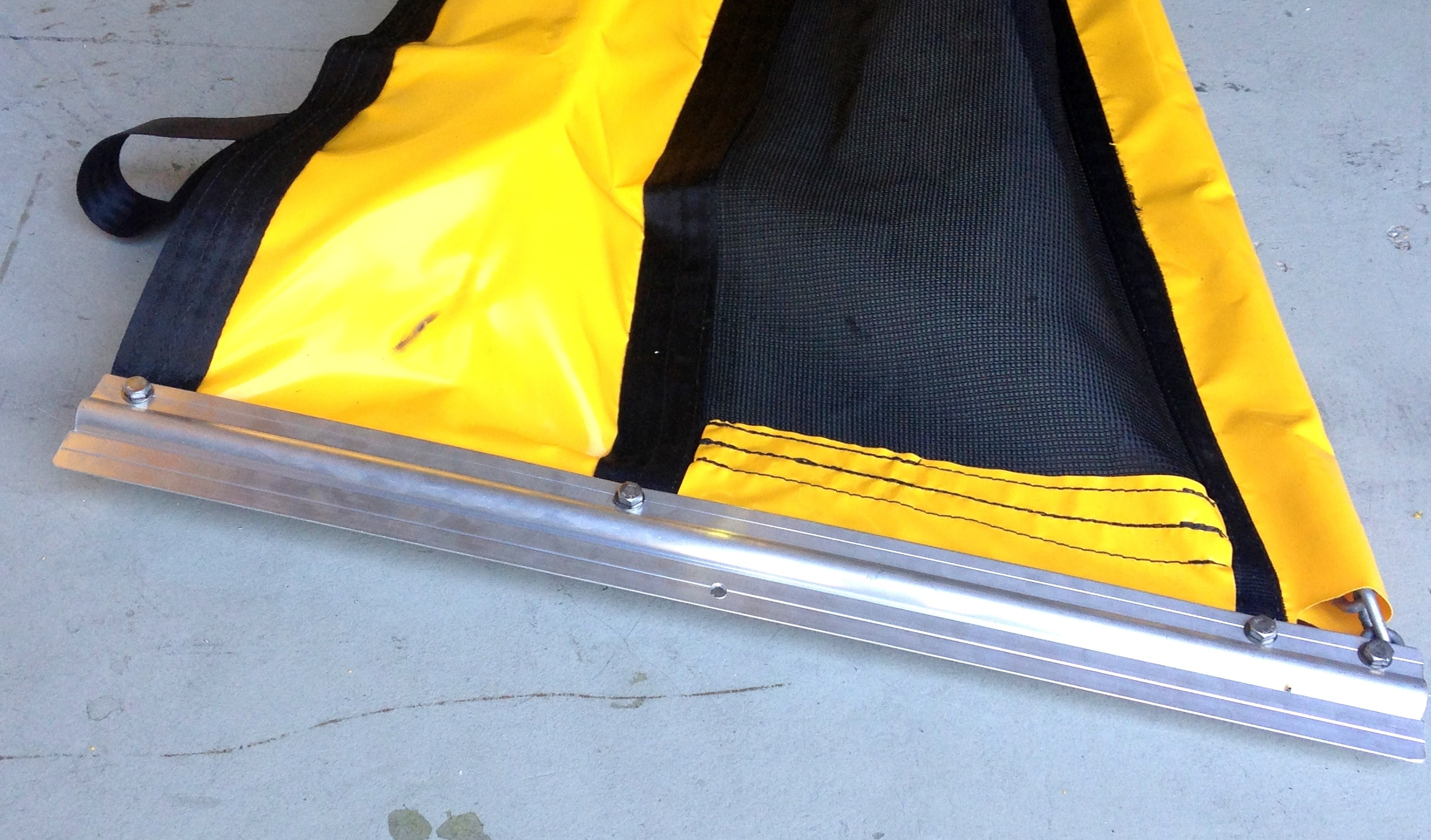
Affordable and reliable Hi-grade crumble resistant, closed-cell foam.
The skirt on a weed boom is built from horticultural UV stabilised woven cloth promoting a larger pore size that is more effective for stopping weed, rubbish, and floating debris.
PRO TIP
Silt curtains are not effective floating debris booms or weed curtains as they foul easily due to their smaller pore size and heavier lag in the water. Weeds can pass beneath a silt curtain if the filtration medium is too fine. Call us for advice about control measures if you’re not sure what product would best suit your project.
Our standard weed boom has a 300mm skirt and 100mm or 150mm freeboard depending on the water conditions ensuring a good containment barrier. We manufacture custom weed and debris booms to suit specific site applications with deeper heavier grade skirts, larger floats, and external deflection floats for heavier debris when it’s required to implement an effective plan for you.
Standard Weed Boom Configurations:
| Model Number | Length | Free Board | Draft | Chain/Ballast |
|---|---|---|---|---|
| WB15300 | 15 | 100mm | 300mm | 6mm |
| WB15300H | 15 | 150mm | 300mm | 8mm |
| WB10300 | 10 | 100mm | 300mm | 6mm |
| WB10300H | 10 | 150mm | 300mm | 8mm |
If viewing on a mobile device please slide from right to left to see full table data.
* Heavy Duty options available
Technical Terms:
FREEBOARD: Distance from water line to top of the float chamber
SKIRT: Material used between the float and the ballast chain pocket (PVC)
DRAFT: Distance from the water line to the bottom of the curtain
BALLAST: Area of curtain closest to the sea floor, weighted with gal chain to ensure curtain shape and integrity
CONNECTOR: ASTM standard, Z-connector
Types Of Aquatic Weeds
Before setting out to control weeds with a weed boom you first need to understand the type of weed you’re dealing with and its characteristics. If unsure this guide from the department of primary industries is a good first point of reference.
The Impact Of Aquatic Weeds
If left uncontrolled aquatic weeds have a major impact on the local ecology, due to competing with local species, blocking light penetration, and/or reducing oxygen. This can have a negative impact on native plants, fish, and birds, upsetting the natural balance of the waterway.
Most Problematic Aquatic Weeds
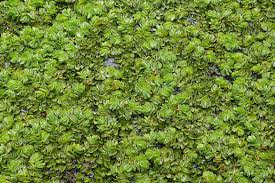
Salvinia Molesta:
Salvinia Molesta is a floating fern-style weed. It’s free-floating and doesn’t attach itself to the soil. It produces large blankets in aquatic systems reducing sunlight and oxygen. Salvinia can in some cases cover a complete aquatic system choking the waterway completely.
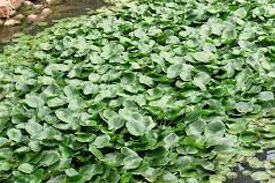
Water Hyacinth:
Water Hyacinth grows on the water’s surface, creating a thick mat that prevents direct light and oxygenation.
When prevalent, it has the capacity to affect the ecological balance of local flora and fauna and increase the local mosquito population. In extreme cases, the weed can grow to be so thick access to the waterway by boat become very difficult
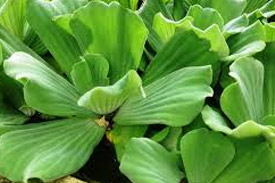
Water Lettuce:
Water lettuce is another free-floating and very fast-growing aquatic weed.
It is most commonly found in Qld, NSW, and WA.
Like Water hyacinth and Salvinia Molesta, it also has the capacity to produce a thick mat that prevents direct sunlight and oxygenation.
Unfortunately, many parts of Australia are ideal environments for weed and algae bloom.
When planning to implement a floating debris boom you must anticipate rainfall and how it affects the overall conditions such as force and levels to ensure your containment barrier remains effective under rain events.
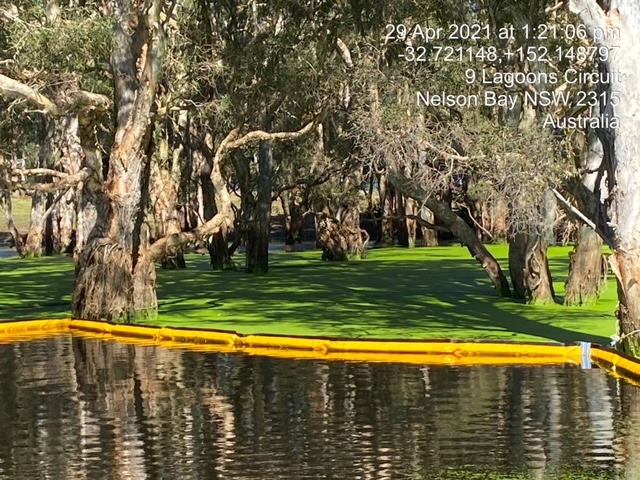
Weed And Debris Containment
Boom Installation
There are many ways to utilize floating debris or weed boom and in most cases, the best result will be a site-specific configuration. If you need help configuring an effective weed and rubbish control zone talk to us today.
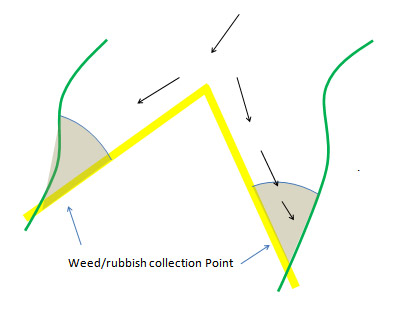
Reverse V: Application, Weed And Rubbish Containment, Slow To Moderate Moving Water
The ‘Reverse V’ can be used on small and larger-scale deployments to control rubbish, weed, and aquatic plants that are free-floating in the water. The purpose of the V configuration is to deflect the rubbish or weeds toward the bank of the catchment area making less work for harvesting, spraying, or other types of control whilst dividing the flow velocity. The reverse V allows operators to remain on the banks of the catchment area to control the collected weeds, as opposed to having to go into the water-saving time, money and resources. The reverse V configuration requires more booms than a standard installation but it’s still regarded by many as saving to operators because of the ease of control once weed is collected on the banks.
One-Way Slice: Weed And Rubbish Containment, Slow-Moving Water
The ‘Slice’ can be used to control weed, debris, and rubbish containment and has two main anchor points on land, then as many as required throughout the remaining length of the boom. Like the reverse V, it promotes collection without needing to get in the water but towards one side of the bank of the aquatic system only. A slice should be used in slow-moving waters only as it spans the entire distance promoting one-point collection. Ideally used if the adjacent bank is inoperable.
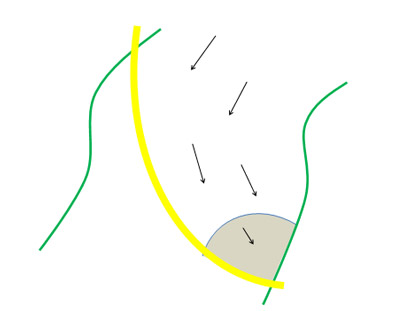
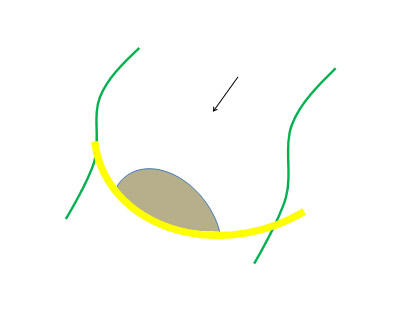
Conventional Installation: Weed And Rubbish Containment, Slow To Moderate Moving Water
A conventional installation requires operators to harvest from the water. The advantages of this setup are load distribution, scalability, and reliability. Establish two land points and anchor in between as required. Conventional systems may be used when the banks are inoperable or side bank collections are not feasible.
Supplying Products Anywhere in Australia
We are known for our timeliness on orders. We ship your in boxes, pallets, skids and containers and have access to a number of freight companies.






